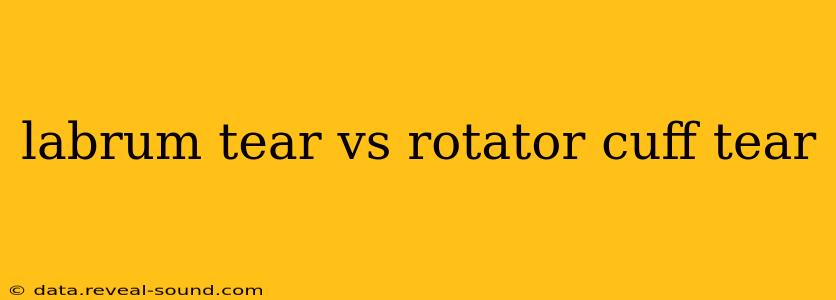Shoulder pain is a common complaint, often stemming from injuries to the labrum or rotator cuff. While both structures are crucial for shoulder stability and function, they differ significantly in their location, function, and the types of injuries they sustain. This article clarifies the key distinctions between a labrum tear and a rotator cuff tear, helping you understand the potential causes, symptoms, diagnosis, and treatment options.
What is a Labrum Tear?
The labrum is a ring of cartilage that surrounds the glenoid, the socket of the shoulder joint. It acts like a gasket, deepening the socket and enhancing shoulder stability. A labrum tear occurs when this cartilage is damaged, often due to a sudden injury like a fall or forceful overhead movement. It can also develop gradually due to repetitive stress or overuse. Tears can range in severity from small, insignificant fissures to large, complete detachments of the labrum.
Types of Labrum Tears:
- SLAP (Superior Labrum Anterior to Posterior) Lesion: This common type of tear affects the upper part of the labrum, often involving the biceps tendon.
- Bankart Lesion: This tear occurs at the front of the labrum, frequently associated with shoulder dislocations.
- Other Lesions: Tears can occur in other parts of the labrum as well.
What is a Rotator Cuff Tear?
The rotator cuff is a group of four muscles and their tendons that surround the shoulder joint. These muscles (supraspinatus, infraspinatus, teres minor, and subscapularis) help to stabilize the shoulder, allow for a wide range of motion, and facilitate powerful movements. A rotator cuff tear occurs when one or more of these tendons are damaged, usually through overuse, trauma, or degeneration. Tears can range from small partial tears to large, complete ruptures of the tendon.
Types of Rotator Cuff Tears:
- Partial Tear: The tendon is partially torn, but not completely separated.
- Full-Thickness Tear: The tendon is completely torn through.
- Retraction Tear: A more severe tear where the torn tendon has retracted significantly from the bone.
Labrum Tear vs. Rotator Cuff Tear: Key Differences
| Feature | Labrum Tear | Rotator Cuff Tear |
|---|---|---|
| Location | Glenoid labrum (cartilage ring) | Rotator cuff tendons (muscles & tendons) |
| Function | Shoulder stability, joint congruency | Shoulder movement, stabilization, strength |
| Common Causes | Sudden injury, repetitive stress, overuse | Overuse, trauma, degeneration, aging |
| Symptoms | Clicking, popping, catching, instability, pain, limited ROM | Pain, weakness, limited ROM, crepitus (grinding sound) |
| Diagnosis | MRI arthrogram, physical exam | MRI, X-ray, physical exam |
| Treatment | Conservative (rest, PT) or surgery | Conservative (rest, PT, NSAIDs) or surgery |
What are the symptoms of a labrum tear?
Symptoms of a labrum tear can vary, but common ones include a feeling of clicking, popping, or catching in the shoulder, instability or giving way of the shoulder, pain, and limited range of motion (ROM). Some individuals experience only mild discomfort, while others have significant pain that interferes with daily activities.
What are the symptoms of a rotator cuff tear?
Symptoms of a rotator cuff tear often include shoulder pain, weakness, limited range of motion, and crepitus (a grinding or crackling sound during shoulder movement). Pain can be localized to the shoulder or radiate down the arm. Severe tears might lead to significant weakness and inability to lift objects.
How are labrum and rotator cuff tears diagnosed?
Both labrum and rotator cuff tears are typically diagnosed through a combination of physical examination and imaging studies. Physical exams assess range of motion, strength, and stability. Imaging techniques, such as X-rays (to rule out fractures), MRI, and MRI arthrogram (for better visualization of the labrum), are used to confirm the diagnosis and assess the extent of the tear.
How are labrum and rotator cuff tears treated?
Treatment for both labrum and rotator cuff tears depends on the severity of the injury and the individual's symptoms. Conservative management, including rest, physical therapy, and nonsteroidal anti-inflammatory drugs (NSAIDs), is often the first approach. Surgery may be necessary for severe tears or those that fail to respond to conservative treatment. Surgical techniques for labrum tears often involve arthroscopy, while rotator cuff repairs can be done arthroscopically or through open surgery.
Conclusion:
Understanding the distinctions between labrum and rotator cuff tears is critical for proper diagnosis and treatment. While both can cause significant shoulder pain and dysfunction, their underlying causes, mechanisms of injury, and treatment approaches differ. If you experience shoulder pain, it's essential to consult a healthcare professional for accurate diagnosis and personalized management. Early intervention can often lead to better outcomes and prevent long-term complications.
